 advertisements advertisements
|

|
Space shuttle simulator returns to NASA to be restored for display
June 10, 2021 — A space shuttle has returned to NASA's Johnson Space Center almost a decade after it was last "flown."
The shuttle, or more specifically, a simulator of the winged spacecraft's flight deck, which provided astronauts with a sense of the motion they would experience during their launch and landing, arrived back in Houston nine years after a plan to put it back into use fell through. A volunteer team is now working to prepare the Motion Base Simulator (or as it was also called, the Shuttle Motion Simulator) for its permanent display at the Lone Star Flight Museum located at nearby Ellington Airport.
"Last week, we had two shipments: on the first, were all the boxes and racks, as well as the general purpose computers, which we are putting into safe keeping at NASA. Then, on Thursday, June 3, we moved the cabin and instructor operator consoles," said Bonnie Dunbar, a former NASA astronaut who trained for her five shuttle missions using the motion base simulator and now serves on the board of directors for the Lone Star Flight Museum.
Having already raised more than $40,000 of the $75,000 the project is expected to cost when complete, the museum reached an agreement with NASA to use a vacant spacecraft acoustic test facility at Johnson Space Center for the simulator's restoration. The work is being done by group a retired NASA engineers, led by Carl Brainerd, who helped develop and worked on the simulator throughout its 34-year history, from 1977 to 2011.
"What they said to me is that they're finally going to have some fun," Dunbar told collectSPACE in an interview. "This is something they've been looking forward to."
Stops and starts
The Motion Base Simulator was unique among NASA's shuttle training devices because it was able to move. Mounted atop a platform supported by six hydraulic, computer-controlled legs, the cabin could pitch forward and back, side to side and be lifted up and down to approximate the orientation of the orbiter during different phases of flight.
After its last use by the STS-135 crew in 2011, NASA reached an agreement with Texas A&M University to relocate the complete simulator to College Station, where it would be put back into use as a teaching and engineering development tool. But after it was moved, the plans for its second "mission" fell apart.
"Texas A&M worked very hard to get it and keep it in Texas," said Dunbar, who also teaches aerospace engineering at the university. "They raised $500,000 and intended to put it in the University Services Building, because they were going to restore the simulator's motion and it had all the necessary reinforcements. That was the plan."
"It's not entirely clear what happened, but the building became unavailable and the simulator went into storage," she said.
When Dunbar joined the school's faculty in 2016, she was tapped to find a new home for the motion base simulator. At first, the Lone Star Flight Museum was not a clear choice. The museum at the time was located in Galveston and it had suffered significant damage from a hurricane. Even after moving to Ellington, the museum's opening was delayed by another storm.
Lone Star also did not have the floor space to conduct the restoration. But with the help of former Johnson Space Center directors Gerry Griffin and George Abbey, a fundraising campaign began and the use of the Apollo-era Vibration and Acoustic Test Facility (Building 49) was approved.
Moving forward
The goal now is to have the simulator's restoration mostly complete by November, to coincide with the 40th anniversary of STS-2, the second space shuttle mission. The motion base simulator will not be in motion when it goes on display, but it will still be a dynamic exhibit, says Dunbar.
"We've got everything to restore the cabin to a fixed base, basically static," she said. "We have some short term plans, which means putting all the displays in and getting the lights going. But we also have a long range plan, which will probably include replacing the old lights with LEDs because they don't make the old fixtures anymore."
The plan also includes repainting the exterior of the cabin and building a wheeled cradle to ease in moving the cabin into and around the museum.
And then there are the elements that will bring the simulator back to life.
On the simulator's very last run in 2011, Brainerd made a recording of what the displays were showing while the STS-135 astronauts practiced flying the orbiter.
"So we can run audio of the crew talking and have video of the simulator in motion to show what it did." said Dunbar. "If we put that out with a display board showing all of the screens and a description of what is happening, you can then peek into the cabin and still have an experience."
Eventually, astronauts may be brought in for weekly talks about flying the shuttle, helping to place the simulator into the context of the Lone Star Flight Museum and its other exhibits.
"Our emphasis has been on winged airplanes," said Dunbar. "And that transition of aviation into space and the fact that the shuttle had wings and flew like a glider is very important. We are teaching visitors and students about the principles of flight and that also applies to the shuttle." |
|
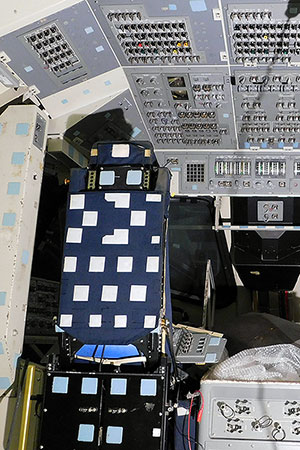
A look inside the space shuttle motion base simulator after it arrived back at NASA's Johnson Space Center on June 3, 2021, nine years after it left. Once restored, the simulator will go on static display at the Lone Star Flight Museum at Ellington Airport. (Bonnie Dunbar)
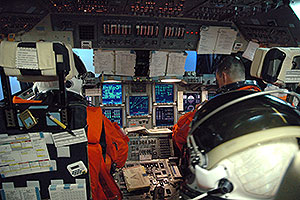
The motion base simulator was used by all 135 space shuttle crews to train for their missions between 1981 and 2011. (collectSPACE)
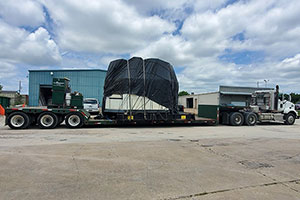
The cabin for the space shuttle motion base simulator arrived back at Johnson Space Center by truck on June 3, 2021. (All American Riggers/Johnny Carson)

The space shuttle motion base simulator cabin after being moved into Building 49 at NASA's Johnson Space Center. (Bonnie Dunbar) |
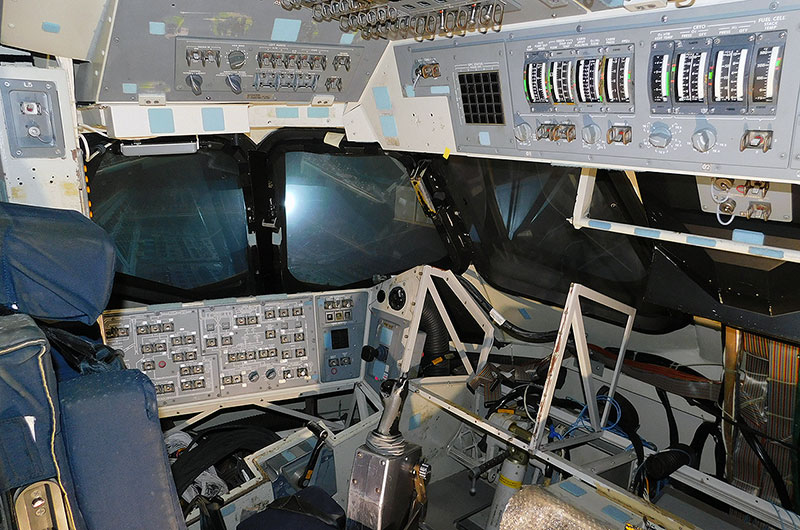
The commander's station inside the space shuttle motion base simulator as it appeared just after arriving back at NASA's Johnson Space Center on June 3, 2021. The simulator is being restored for display at the Lone Star Flight Museum at Ellington Airport, Houston. (Bonnie Dunbar) |
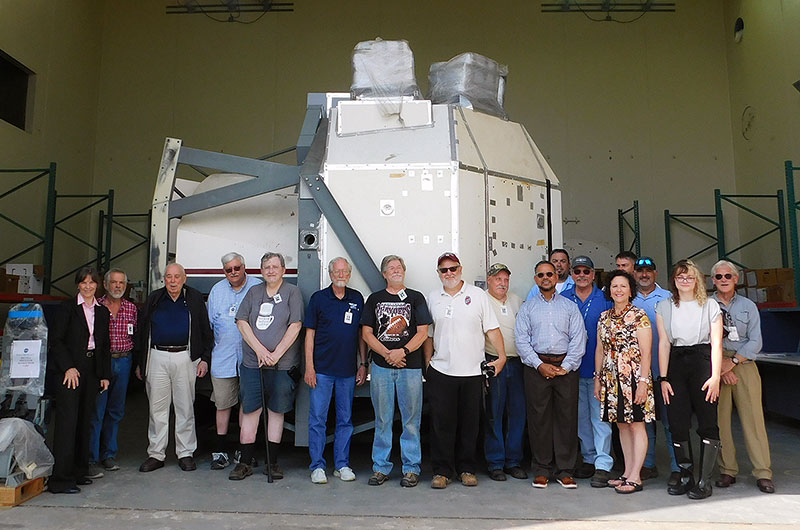
The team working on the Lone Star Flight Museum's exhibit of the space shuttle motion base simulator, including former astronaut Bonnie Dunbar (at far left), former Johnson Space Center director George Abbey (third from right), and lead restorer Carl Brainerd (sixth from left). (Bonnie Dunbar) |
|

© 1999-2025 collectSPACE. All rights reserved.
|
|

|

|
